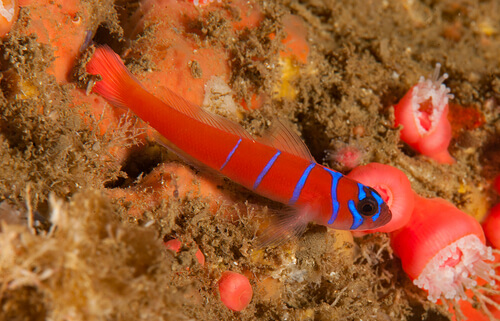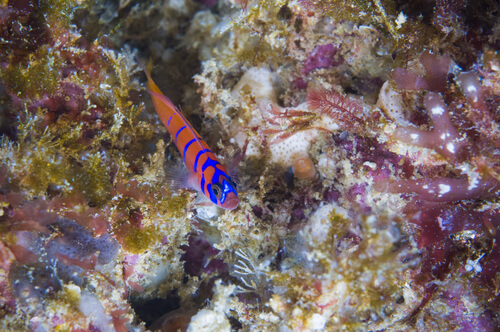Catalina Goby: Care, Diet, Tank Mate Compatibility & More
Posted by on 4/07/2023
We use affiliate links and may receive a small commission on purchases.
Some of the most common gobies in the marine aquarium hobby include the orange spotted goby and diamond goby, but other species fall under the Gobiidae family that are equally attractive and interesting.
One such fish is known as the Catalina Goby, and its small size and unique coloration make it one of the most beautiful of all goby fish. Hobbyists looking to care for this species will be challenged as the fish has very specific care requirements. In this post, we'll discuss how to care for the species, diet recommendations, tank mate options, and much more.
January's Giveaways on Light Fish
Species Summary
The Catalina goby (scientific name: Lythrypnus dalli) is a marine fish under the Lythrypnus genus that hails from the eastern Pacific, off the coasts of California and further south towards Peru. Scientifically named after American explorer William Healey Dall , the species is also commonly referred to as the Blue-banded goby.
Unlike some of the more commonly seen aquarium gobies native to the Indo-Pacific, the Catalina goby prefers an aquarium with cooler temperatures to match its native habitat.
The species is quite social and rarely shows aggression towards other tank mates.

Appearance
The Catalina goby is a brightly colored goby, with a predominantly red body, broken up by vertical blue stripes. Similar to other gobies, the Catalina features an upturned mouth, which it uses to feed on small crustaceans.
The species has a submarine-shaped body that tapers towards the fish's orange-colored tail, while the species' dorsal, pectoral, pelvic, and anal fins remain mostly translucent. As the fish ages, its colors will appear more vibrant.

Male vs Female
Hobbyists looking to distinguish a male and female Catalina goby should look towards the fish's dorsal fin, which will appear longer in males. Males will also tend to be a bit larger than females.
The Catalina Goby is also capable of bi-directional sex change. If a more dominant male is introduced into an aquarium, the existing male will turn female, so that only one male is present in the tank.
Size
Catalina gobies are very small fish, and will only grow to reach an inch in length.
Their small size makes them an excellent option for a coldwater nano aquarium.
Catalina Goby Care
Caring for a Catalina Goby comes with its set of unique challenges. As a cold-water fish, you're much more limited when it comes to stocking options. Many aquarists will dedicate a tank specifically for the species.
Even though these fish have a short lifespan, you'll want to do everything in your power to provide these fish with a healthy life.
Lifespan
When provided an optimal environment and well-balanced diet, the Catalina goby will live for about 2 years in captivity.
While such a short lifespan may seem surprising, it's on par with many other Gobiidae species.
Tank Size
Due to their small size, only a 10-gallon aquarium is required for a Catalina goby.
These fish are perfect for a nano aquarium, and can even be kept in small groups.
Acclimation
Catalina gobies should be drip acclimated using a drip acclimation kit . It's important to match the salinity and temperature of the fish's transport bag with your aquarium water parameters.
Salinity levels should be within .001, and since the Catalina goby prefers cooler temperatures, you'll want your display tank to be somewhere between 60-70°F.
Water Conditions
Besides their preferred temperature, the Catalina Goby will thrive in the same water conditions recommended for most marine fish.
Aim for the following:
Specific Gravity: 1.020-1.025
Temperature: 72°F-78°F
dKH: 8-12 dKH
pH: 8.1-8.4
You can monitor your aquarium temperatures using a reliable aquarium thermometer .
Tank Setup
In the wild, the Catalina goby inhabits the rocky areas off the western coasts of North and South America. Using naturally-formed crevices, the fish will eagerly retreat to these safe areas when threatened.
We'll want to re-create this environment as best we can in an aquarium environment.
Hobbyists will want to provide plenty of live rock and create small caves for these fish to retreat into. They aren't very picky when it comes to flow rate, and as bottom-dwellers, tend to hang near the bottom of the tank.
Providing an ecosystem with a sump will be beneficial, especially for those who are considering adding the species to a nano-sized aquarium. The extra water volume provided by a sump will result in a more stable water column.
Common Diseases
Although Gobies may be less prone to diseases compared to species with thin slime coats like the powder blue tang, it is still crucial for aquarists to address and prevent these potential risks.
We strongly recommend quarantining affected fish and new tank additions to prevent the spread of any disease.
Some of the most commonly seen marine diseases are marine ich and marine velvet, which we cover in more detail in our related post.
Food & Diet
Catalina Gobies are carnivores and should be fed a diet consisting of frozen mysis shrimp, brine shrimp, and nutrient-rich pellet foods 2-3 times per day.
You'll need to provide small-sized food for these small fish. As a treat, you can also feed live brine shrimp, which hobbyists may choose to grow in a refugium.
Behavior and Temperament
Catalina gobies have an ideal temperament. They're peaceful towards other tank mates, including their own species. They're also quite social and can be found lounging along the sandbed or perched on top of live rock.
Now and then they might go for a swim, but only for a short duration, after which they'll return to their favorite spots in the aquarium. They're most active during the day, making them fun to observe in an at-home aquarium.

Reef Compatibility
While the Catalina goby won't pick at corals such as torches and chalices, hobbyists should pay attention to their preferred tank temperature.
These fish prefer cooler temperatures, incompatible with a reef aquarium. While Catalina gobies can acclimate to warmer temperatures, we would advise against this approach, which may shorten their lifespan.
Tank Mates
Due to their preference for cold water, hobbyists are quite limited when it comes to tank mate options.
Some compatible tank mates include:
-
Fluffy Sculpin
-
Bluespot Jawfish
-
Eastern Hulafish
-
Kamoharai Blenny
-
Ventralis Anthias
All of the above are suitable for a cold water aquarium when provided with a large enough tank.
Breeding
While the Catalina goby has successfully spawned in captivity, there hasn't been any success in raising the fry into juveniles.
The Catalina goby's cold water conditions present unique challenges for breeders, and sourcing the correct benthic prey for them to feed on has proven difficult.
However, gobies are frequently bred in captivity, with discoveries happening every year, hopefully, we'll see a captive-bred Catalina in the future.
Where to Purchase
Catalina gobies are an uncommon fish, and may occasionally make a brief appearance on our marketplace.
They're occasionally sold by some of the larger online vendors but often sell quickly. You'll want to frequently check their availability if you're in the market for such a unique species.
Conclusion
The Catalina goby is an attractive fish with a fantastic temperament and disposition. However, its coldwater preference may turn off hobbyists unwilling to dedicate a tank to its unique care requirements.
Now that we've covered the basics, do you plan on dedicating a tank to such a unique fish? Let us know in the comments, and be sure to check out our community forum, where you can discuss fishkeeping with other aquarium hobbyists.
January's Giveaways on Light Fish


